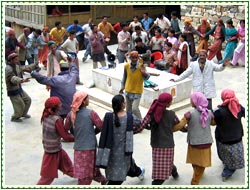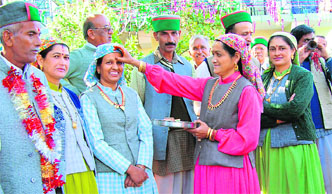|
SOME PICTURES SHOWING CULTURE OF HIMACHAL PRADESH

Devata ji 'sholi ka devata'

Typical old himachali house













Traditional way of welcoming guest in Himachal Traditional dress of women
comprising of rezta(long dress), the
Dhatu (head scarf) and salukaa (waist)
CULTURE OF HIMACHAL CONTD.....
Handicrafts: The geographic isolation of Himachal Pradesh has allowed its people to evolve their own unique tradition of handicrafts. The extensive range includes fine woodwork, traditional embroydory, engraved metalware, beautifully patterned carpets and traditional woollen shawls.
Shawls: Extremely fine and valuable shawls, made from the wool shed by the pashmina goat are popular in Himachal. These shawls are both plain and designed. The right mix of wool can give beautiful shades of grey, blue, mustard and black. Shawl in Kullu are often woven from the wool of angora rabbits. Borders in bright geometric design are also used to add interst to plain coloured shawls.
Carpets: Carpets and blankets are an essential part of Himachali furnishing, and carpets in brilliant colours are woven with a variety of traditional motfits. There are Garudas on flowering trees, dragons, swastikas, flutes to symbolize happiness and lotus blooms to mean purity. Carpets are wooven as furnishing, as carpets saddles for horses ans as blankets or chutkas. They are part of every bride's trousseau.
Metalcraft and Jewellery: Matalcraft is one of the traditional crafts of Himachal Pradesh. The more commonely used metals are silver and copper. The local craftsmanship in casting, ornamenting and engraving of silver has evolved into classic designs. The locally available items include carved silver lamp stands, tea pots, wine cups and metal sculpture. These follow indigenous shapes and are decorated with finally carved patterns depicting flora and fauna as well as stories from legends.
Wood Craft: The most abudant wood in Himachal's forests are the pine and deodar, besides walnut, horse chestnut and wild back mulberry. Intricately carved seats, doors, windows and panels are some examples of the dexterity of Himachal's craftsment. Fruit-bowls, beer mugs, wooden jewellery and carved images are part of their modern range of products.
Stone Craft: The Shivalik hills abound in fine sandstone which is eminently suited for carvingand has played a vital role in perpetuating the stone carvers craft. Numerous stone temples still dot the Himachal landscape.
Painting: Raja Sansar Chand, who ruled Kangra in the later half of the 18th century, a patron of the arts, contributed greatly to the evolution of this genre. His palaces at Nadaun, Sujanpur Tira and various temples in the area were ornamented with murals. Jewel - like miniatures of the period, depicting court life, episodes from the life of Krishna etc., painted in rich colours are still to be seen in museums in India and abroad.
In the remote valleys of Lahaul and Spiti are ancient gompas-Buddhist monastries which form the focus of all cultural life in the area. Some of them, nearly a thousand years old, have exquisite painted murals, stuccos and thangkas.Fine thangkas-scroll paintings on canvas, edged with a border of rich silk, are still created here.
Music: Music is an ephemeral art which has to be felt in. Its very transcendence nature makes it difficult for easy comprehension, specially when it is seperated from ritual or function and is then categorised as art music. To a layman the term "Tribal Music" generally connotes one ofgeographicallyrestricted to a perticular tribe as its own special brand, and the second is a picture of music as a special type passed from generation to generation. To some extent both concepts have some truth in them.
The people of Lahaul and Spiti are quite ignorant about the classical music yet they sing every type of song. The songs have been grouped as social songs, songs related to fairs and festivals, historical songs and romantic songs. These are usually accompanied with dances and various music instruments. Only five notes are used in most of the songs. The combination of sa, re, ma, pa ,ni notes is prominent in the tunes of these songs.
Museums/Gallaries:
State Museum (Shimla): Housed in a charming colonial building, Inverarm, the State museum is located atop a hill that rises above the Chaura Maidan. A selection of Himachal's rich heritage is displayed here. The gallaries house Pahari miniature paintings, stone sculpture of considerable antiquity ans artistic merit assorted bronzes, arms and armour, dolls, anthropological items and numismatic finds.
Kangra Art Gallery (Dharamsala): Inagurated in 1990, this gallery is just above the Kotwali Bazar representing collection of Kangries famous miniature paintings, a range of sculpture, ancient pottery.
Roerich gallary, Naggar (Kullu): Nicholas roerich was a Russian who settled in Naggar. His dream was to unify the world through art. His paintings are on display at his charming cottege at naggar.
Sobha Singh's Gallery Andretta (Kangra): A collection of paintings of celebrated artist Sardar Sobha Singh - Sohini Mahiwal, Heer Ranjha and a lot of religious paintings at display at his old home.
Language: Hindi is the State Language but people mostly converse among themselves in Pahari, which according to Y.S. Parmar has various dialects or 'sub-languages'. Grierson in his linguistic survey had called it 'Western Pahari', and had demarcated its area from Jaunsar Bawar in the Utter Pradesh hills (near Dehra Dun) to Bhadarwah in Jammu & Kashmir. It was on the basis of their distinctive language and culture besides other factors that the hill people in Himachal and Punjab demanded their union and finally got it in 1966.
The various dialects of Pahari spoken in region are Mandiali (in Mandi), Kulvi (in Kullu), Kehluri (in Bilaspur), Hinduri (in nalagarh), Chameali (in Chamba), Sirmauri (in Sirmour), Miahasvi (in Mahasu region) and Pangwali (in Pangi). Besides, there are the dialects of Bhot origin, the Kinnauri, the Lahaulu and the Spitian. All dialects of Pahari are of Sanskritic origin. They have been written differently in different times. In earlier days they were written in Tankri or Thakari, but later during the Muslim period they were written in the Persian script. Still later they come to be written in Devanagri.